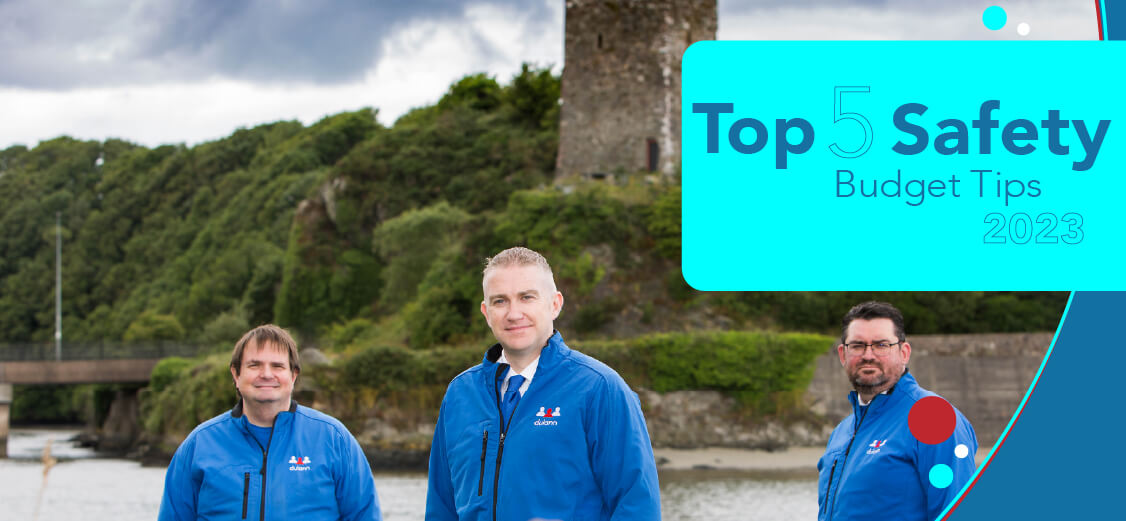It’s that time of year again!! Some Safety Managers have formal budgets for next year, some do not. Some budgets are well set in stone at this stage, others are…..well let’s say, a bit more fluid! Regardless of your situation, most Safety Managers agree that it’s really challenging to set and forecast an accurate safety budget, if for no other reason other than sometimes what happens out on site, on the factory floor, or within the property, are just outside of your control.
This blog is not designed to teach you what you already know, as that wouldn’t be very helpful would it!! Calculating what PPE is necessary for next year, calculating safety salaries based on upcoming work, evaluating changes to Safety Legislation, calculating safety training costs, and achieving basic safety goals are all line items that most people are well accustomed to. What this blog is designed to do, is to help some Safety Managers put together a more holistic budget for the department.
Some safety budgets of course are dictated entirely by finance. Very often the budgets are set based on last year's spend with an allocation for what the Company will be “forced” to spend on unforeseen expenses associated with items such as accident rate. Unfortunately those budgets rarely allow for the allocation of funds for any future improvements and recommendations by the safety department. Very often it is quite difficult for Safety Managers to accurately forecast cost savings, particularly on Digital Compliance Management Systems, and as such any future-proofing recommendations normally take far longer to implement than what is in the best interests of the Company. Safety Managers after all, are not compiling detailed financial business cases and return on investment scenarios, every single day!
Hopefully this brief blog will assist some of you out there with your 2023 Safety Budgets!
Table of Contents
- Understand your Organisations Business Objectives for the Coming Year
- Align Management Vision with the EHSQ Vision
- Proactive Safety Budget Based on Real Safety & Business Intelligence Data
- So Let’s Talk Frankly!
- Plan for New Trends (or Old Trends that were Simply not Addressed Before)!!
Understand your Organisations Business Objectives for the Coming Year
If your business objectives require a reduction of the cost base by say 10% across the board, then you need to align your Safety Department to that objective. Far too many people simply try to hold on to the budget that they had last year, and then set about justifying that expenditure. That’s a perfectly fine strategy to take, but in order to gain credibility at the boardroom table, you do need to conduct the exercise of how you can reduce costs in tune with the business objectives. Please note that this may mean that you need to increase spend on certain initiatives in order to reduce costs. An example of such an exercise (no such thing as a free lunch), is to see if you can do old things in new ways. On a more specific level, if you are conducting 100 plant inspections a year using paperwork, how much does that actually cost versus deploying a digital system where plant inspections can be completed on your phone? Some line items (both direct and indirect) to consider are:
- The actual inspection will be at least 20% quicker by completing it digitally on your phone using QR code technology and scanning the equipment, as opposed to using pen and paper. Could those people be more efficiently deployed doing more high value activities?
- Using paperwork however; how long does it take and how much does it cost for an inspector to complete the administration? File the inspection, maybe complete an excel spreadsheet, communicate the inspection to HQ, retrieve the inspection when required! Surely this person is better deployed in the business doing more higher value add activities.
- Using Paperwork, the real slow down however, is that the inspector has to communicate any corrective actions and spend time following up, and all probably using email and excel. Using digital, this is all automated.
Certainly this must take hours every week! That is leaving aside reporting for Management Meetings which is of course all automated using digital systems. Paying someone 70,000 a year to use excel just doesn’t seem like the most efficient use of resources. The savings can add up quite quickly.
We currently have one client that operates digital plant inspections across 14 sites, and apart from making their Safety Department far more efficient and cost effective, the other benefits are that they now see information in real time, so therefore non-conformances are picked up quicker, and any plant that is not safe to use is brought back into the system sooner, rather than having to hire replacements. Has anyone costed the downtime and replacement costs associated with “not safe to use” equipment? Imagine shaving a couple of hire days off every year?
Align Management Vision with the EHSQ Vision
Lots of companies have taglines such as “Zero Incidents and Zero Injuries ”or “Zero Harm”. There are a number of reasons for this type of approach, and most of which are well intended. As Safety Manager, however, it is important that you are able to fight for and justify a budget that will help the department and the Company achieve the very public company tagline, otherwise it's nothing more than a PR exercise. So in our opinion, the tagline must have a properly resourced safety budget, and if not then change the tagline, because it is one that is already doomed to fail even before the year starts.
Proactive Safety Budget Based on Real Safety & Business Intelligence Data
Depending on the resourcing of the Safety Department, the size of the Company, and the culture of the Organisation, a properly costed budget may exist, but for many it does not. Let’s give an example by focusing on one area alone and that is in the area of Accident & Incident Reduction:
- Company X has 6 Incidents by the end of Q2.
- Each Incident (properly costed, please see our blog on the true cost of safety by Mary Darlington) costs the Organisation €1,500, so we know we have spent €9,000 so far this year.
- Using a digital system to extrapolate data, the Company can immediately see it will cost them €18,000 by year end if nothing changes. This calculation is normally easy to work out and is done by most.
However, using digital systems you can see exactly what hazards caused the incident types e.g. slip, trip and fall, and if configured correctly you can then predict the high risk staff members that haven’t undergone slip, trip and fall training. You can immediately deploy a brief online course to help reduce the company risk and overall spend, by trying to reduce the incident rate by a certain amount, say for example from 12 to say 9. And you can now also start to proactively address the hazards and again the savings start to mount up as well as having real data to defend and fight for your safety budget.
This type of statistical and factual data is what Safety Managers need to be arming themselves with in order to gain greater credibility at the board room table. It allows these Managers to say, for example, ‘we hope to reduce the overall cost of X by €4,500 but we need to spend €500 on a certain campaign’. Results can then be tracked and monitored automatically.
So Let’s Talk Frankly!
All of the above doesn’t just mean department savings, but it can certainly also mean lower insurance costs, decreased lost time on projects and much more. That is not to mention happier and more productive employees. The reality is that your Safety Budget should not be a simple paper submission to finance, just before an imposed deadline. There should be a number of meetings with finance ahead of your submission, where you can agree on the actual financial savings that are costed by the actual financial people. Don’t just look at direct costs, because believe it or not, that is actually the smallest company spend. All too often these indirect elements are not talked about or costed, and as such are often glossed over or forgotten about at Safety Department level. They do however have a real impact on the Company and on your Safety Budget for 2023, whether you address it or not.
Plan for New Trends (or Old Trends that were Simply not Addressed Before)!!
Covid changed the way we work forever, although be it in some industries more than others. What has changed fundamentally for all though is how people have expanded their view of safety from just being physical, to being far more holistic than that. “Good to talk Breakfasts”, “Mental Health Talks”, discussions on work/life balance, and much more are now seen as a key ingredient in company efficiency through reduced absenteeism, higher productivity, lower rate of leavers etc.
Whilst there is no concrete guide for how to define the impact that such initiatives will have on a workforce, you must take some sort of a stab at it, otherwise why do them in the first place, apart from some form of feel good factor! Recent research reveals that for every euro a company invests in company-wide wellbeing initiatives for their colleagues, they can expect to see a return of up to 12 times that amount within a year. So if you spend €10,000 on these initiatives, you would expect to see payback of up to €120,000. This is where the Safety Managers must collaborate with the HR team and Operations to start to measure the impact these programmes have on absenteeism and efficiency. Once you have your own facts, you can then start to increase Safety Budgets based on real figures, and not just on “nice to have” gut feelings.
Freebie tip….sometimes presenting your safety spend as a cost per employee can lead to a much better argument for a larger budget, rather than just looking at a lump sum or an increase/decrease on last year’s spend. Lots of Safety Managers use this initiative, but it's always amazing the amount that don’t consider this way of presenting the facts.
In summary, the more you arm yourself with meaningful metrics, the greater the argument that you will have for investment in your Safety Budget at Managerial level. The more departments you involve in arriving at these metrics, the more you will bring people along on your journey. A Digital Compliance Management System will certainly save the Company money, and it will also make it a more Efficient, Compliant and Safer Workplace.
dulann are a Compliance Management System that make Environmental, Health, Safety & Quality Compliance as Easy as Booking a Flight!







